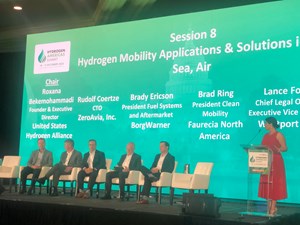News
The future of H2 in the transportation industry
On day 2 of the Hydrogen Americas Summit in Washington D.C., co-hosted by the Sustainable Energy Council and the U.S. Department of Energy, Chair, Founder and executive director of the United States Hydrogen Alliance, Roxana Bekemohammadi moderated a panel titled Hydrogen Mobility Applications & Solutions in Land, Sea, Air followed by a brief Q&A. Bekemohammadi was joined by, Rudolf Coertze, CTO, ZeroAvia, Brady Ericson President Fuel Systems and Aftermarket, BorgWarner, Brad Ring, President Clean Mobility, Faurecia North America, Lance Follett, Chief Legal Officer and Executive Vice President, Westport Fuels and Parker Meeks, President and interim CEO, Hyzon Motors.
After the introductions, the panel began by discussing H2 electric aircraft. "It is imperative that aviation also does its part in becoming carbon neutral and reducing emissions," said Coertze. "If everybody else continues on the path and aviation does nothing, we will be the ones with the sore finger that sticks out at the end."
Coertze went on to describe not only the zero emissions but the economics. The aviation industry finds it challenging to balance the cost of fuel with the need to be cost-neutral with their existing operations.
Bekemohammadi then steered the conversation from the air to land. Fuel cell trucks and the end users, primarily in heavy-duty applications, became the new topic. Parker Meeks tackled this question from the point of view of Hyzon Motors, and he touched on Hyzon's first trial in Canada happening later this year. According to Meeks, the customer base is dictated by infrastructure.
"Where fuel cells are better positioned is where there is a true zero-emission goal, where you've got heavy loads and longer range needed," said Meeks. "Today, our trucks in the U.S. get about 350-mile range with 50 kilos of H2. That's plenty of range to do back-to-base food and beverage and point-to-point freight. Our long-range solution that Hyzon believes in is to switch over to liquid, which is the lowest cost solution." According to Meeks, they are developing this solution with its partner, Chart Industries.
Bekemohammadi then asked Brady Ericson, President of Fuel Systems and Aftermarket for BorgWarner, about H2 internal combustion engines. "The challenge we see for this industry is that fuel cells will be good for some applications, and battery electrics will be good for some applications," said Ericson. "We're going to need a liquified or gaseous fuel, along with electric. We cannot rely on one or the other. If we only say we are going to H2 for fuel cells, I think we are going to be here 10 yr from now without much penetration."
Bekemohammadi then asked Lance Follett about Westport Fuels customers and its work with engine manufacturers. "We have the product in the field running on the high-pressure direct injection system that we developed on biogas in Europe for years," Follett said. "Very few changes have been made, and we are ready to run on hydrogen now. I have no doubt that fuel cells will play an important role, but I think there is an opportunity to build out infrastructure and confidence in hydrogen by introducing the idea of decarbonizing with the hydrogen internal combustion engine."
Finally, Bekemohammadi asked Brad Ring about Faurecia North America's end users. "We want to store the hydrogen onboard for virtual pipelines, for delivery in containers to help supplement the network," said Ring. "Our business is B2B, so we want to understand the end users. We are seeing strong demand in the commercial vehicles space, and we believe that once hydrogen takes, it will take very fast and expand to the other transportation markets."
Story by: Tyler Campbell, Managing Editor, H2Tech


